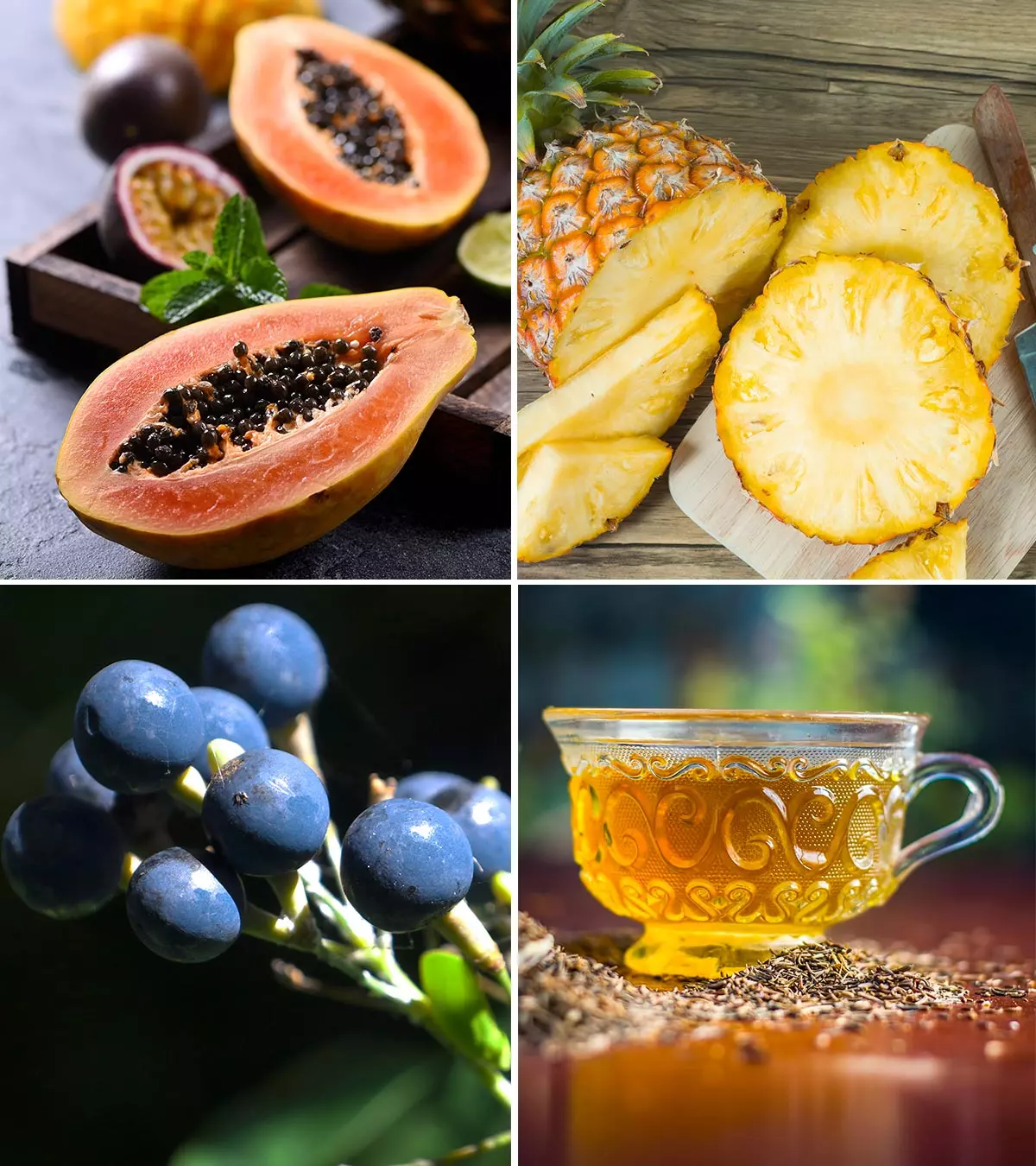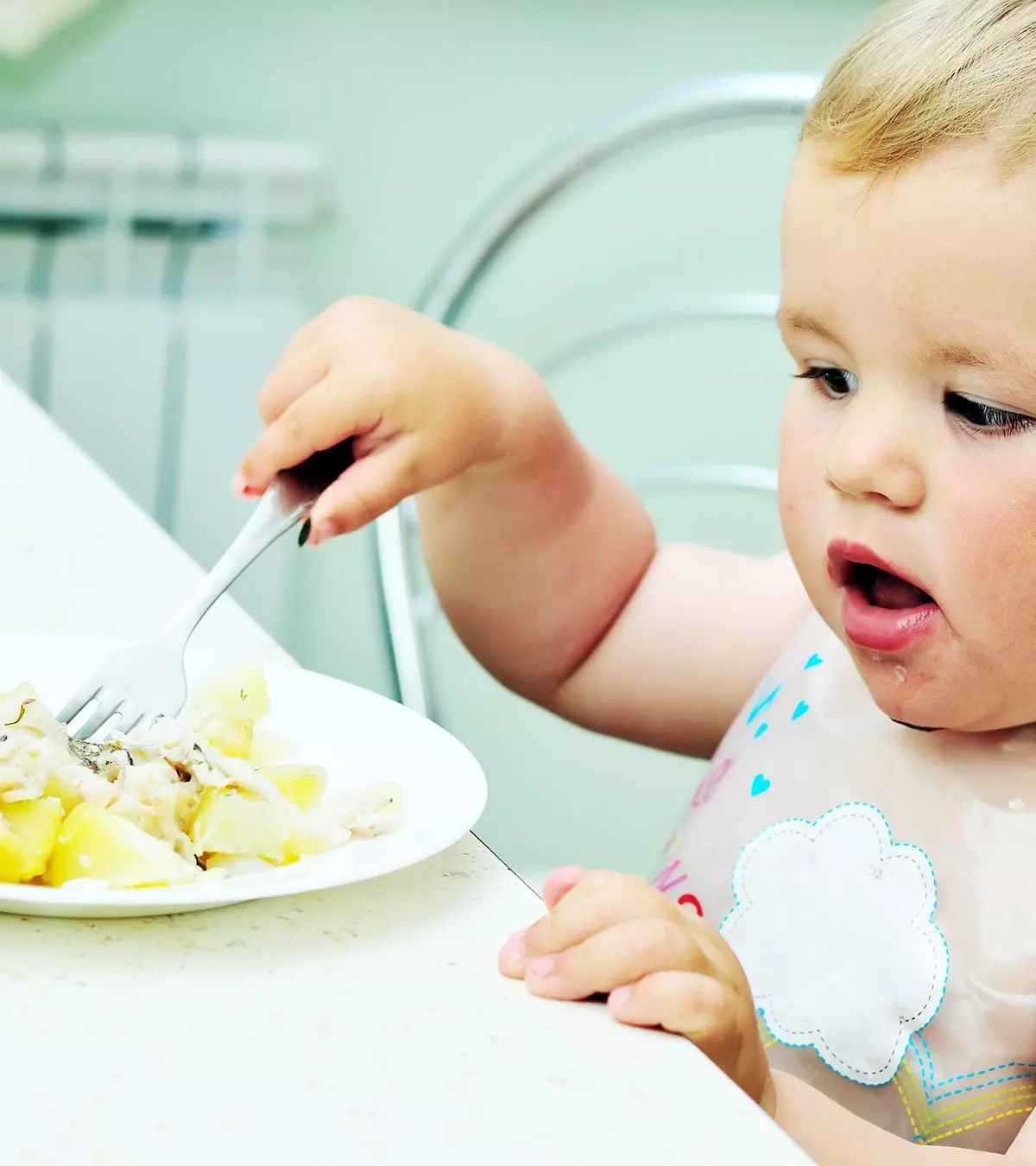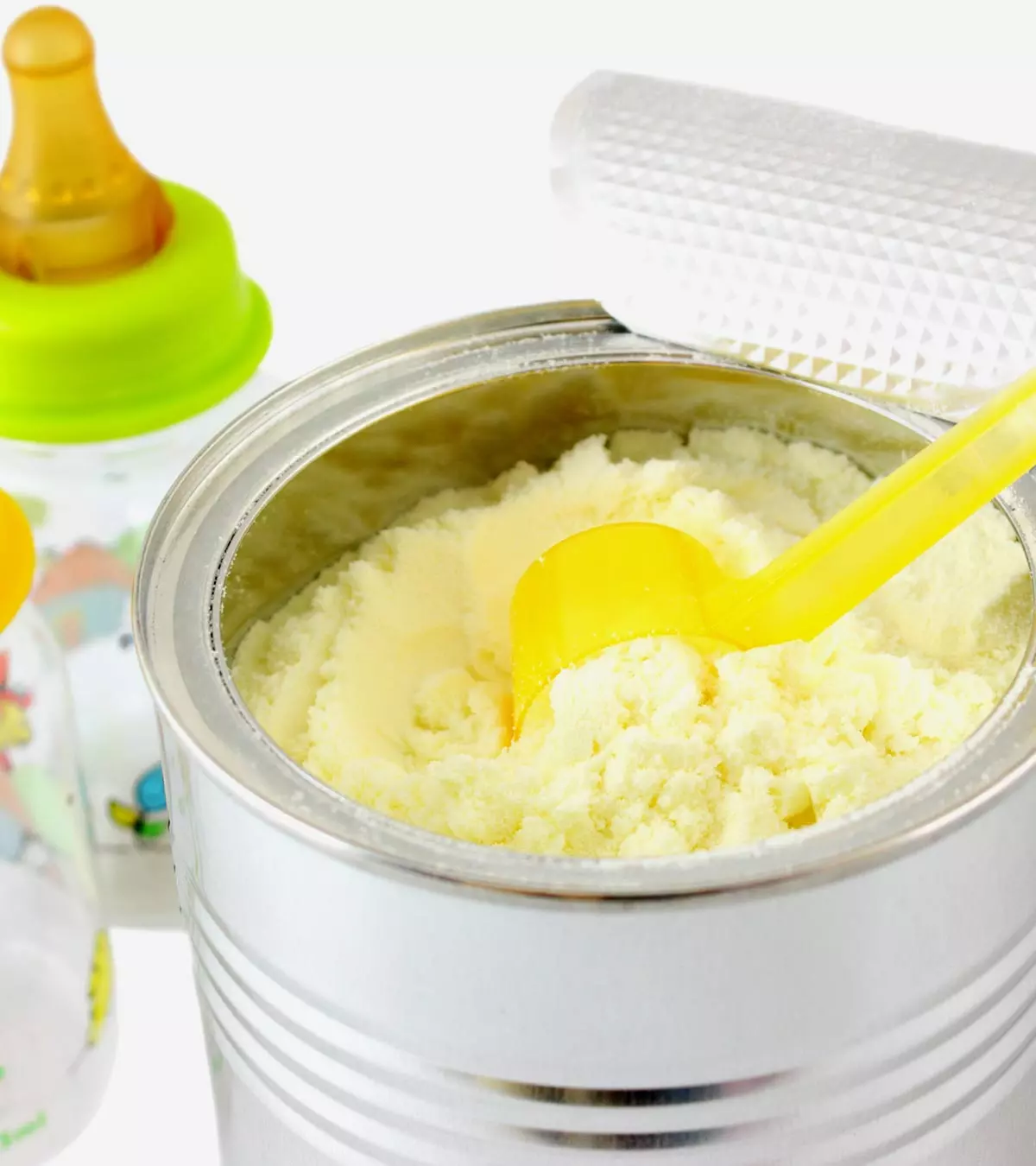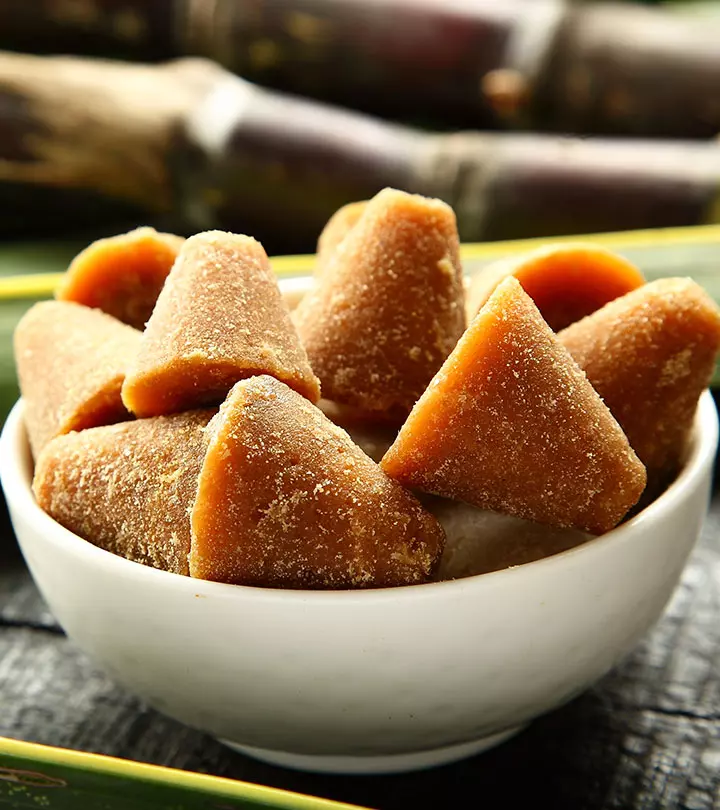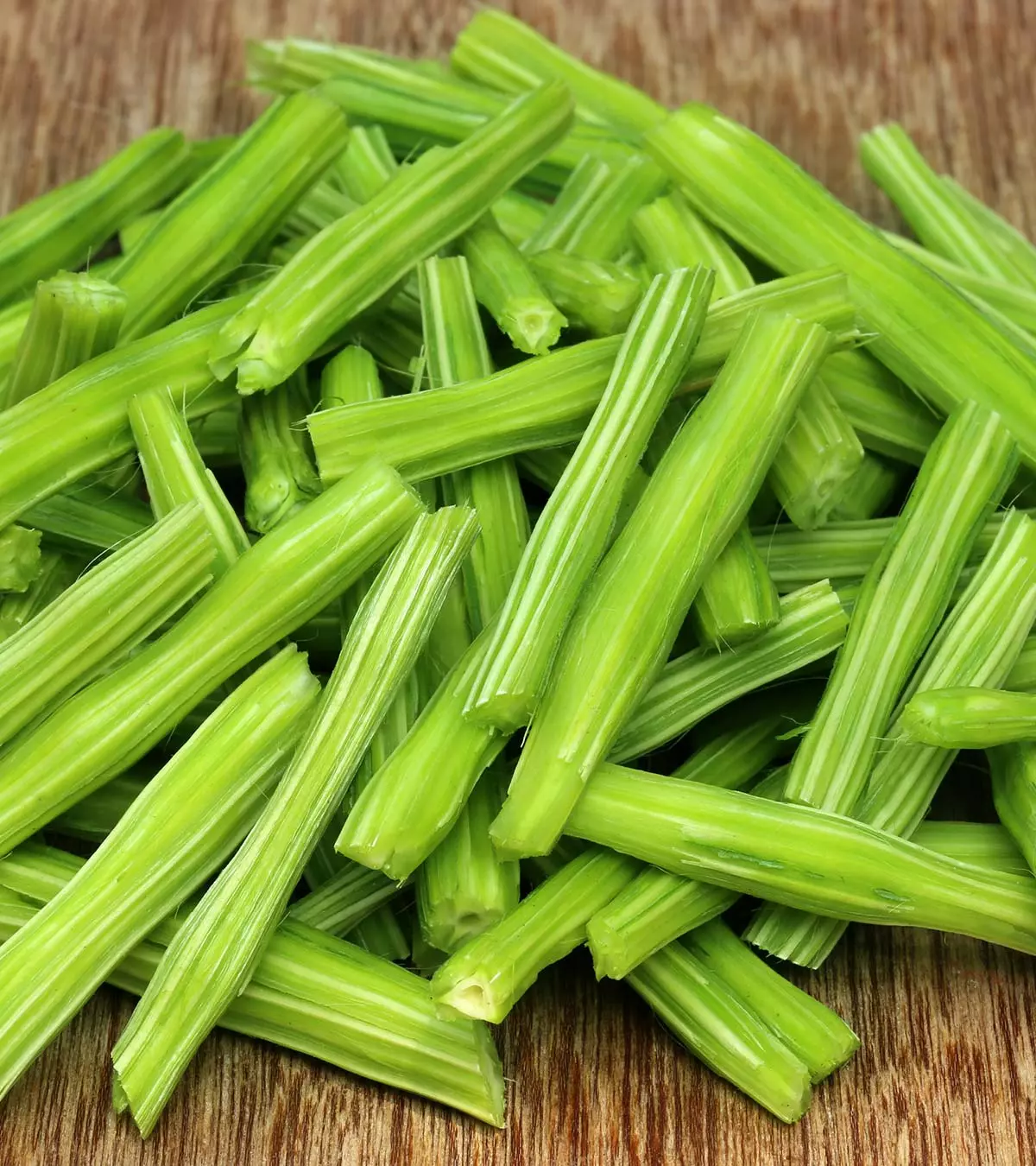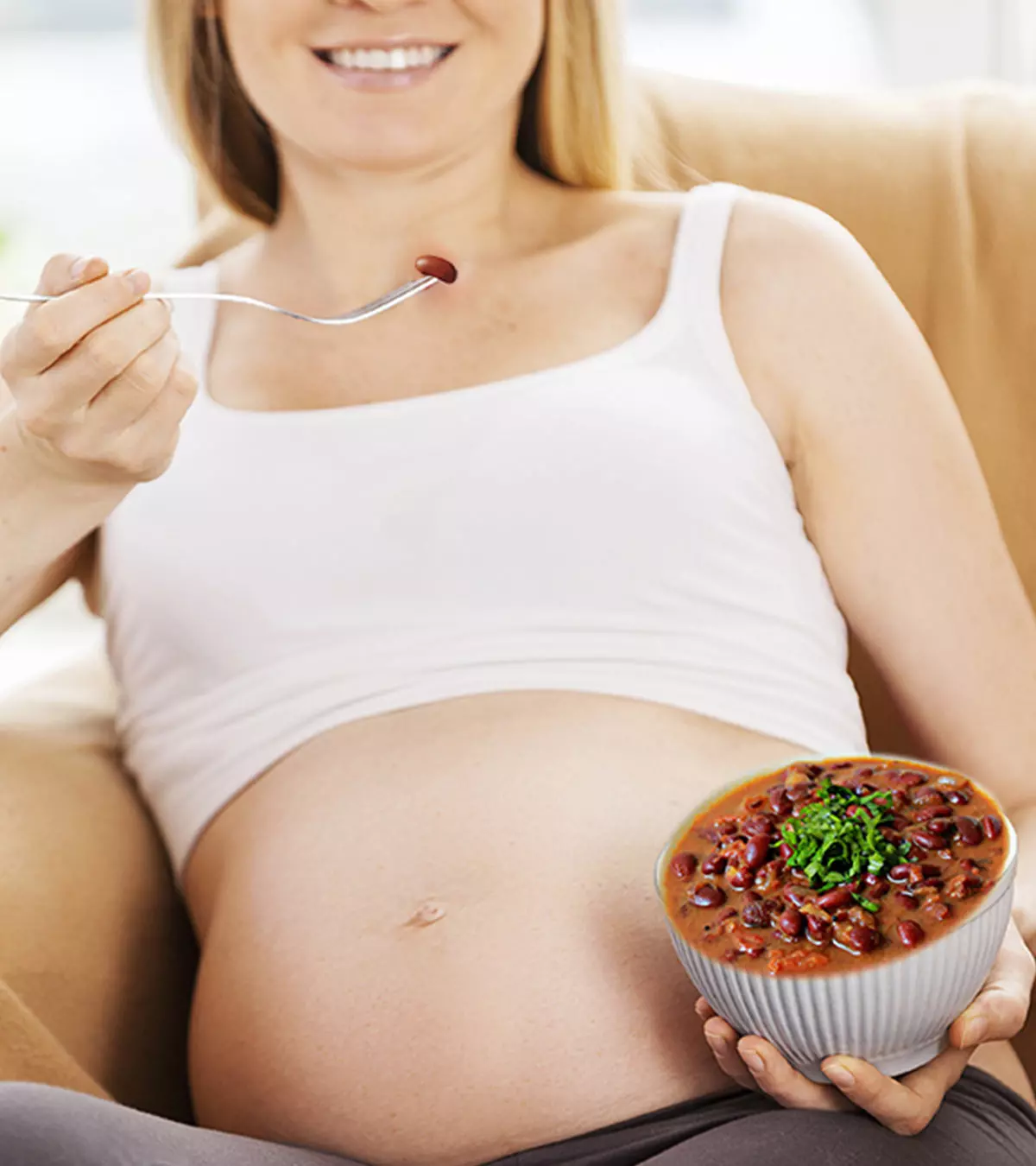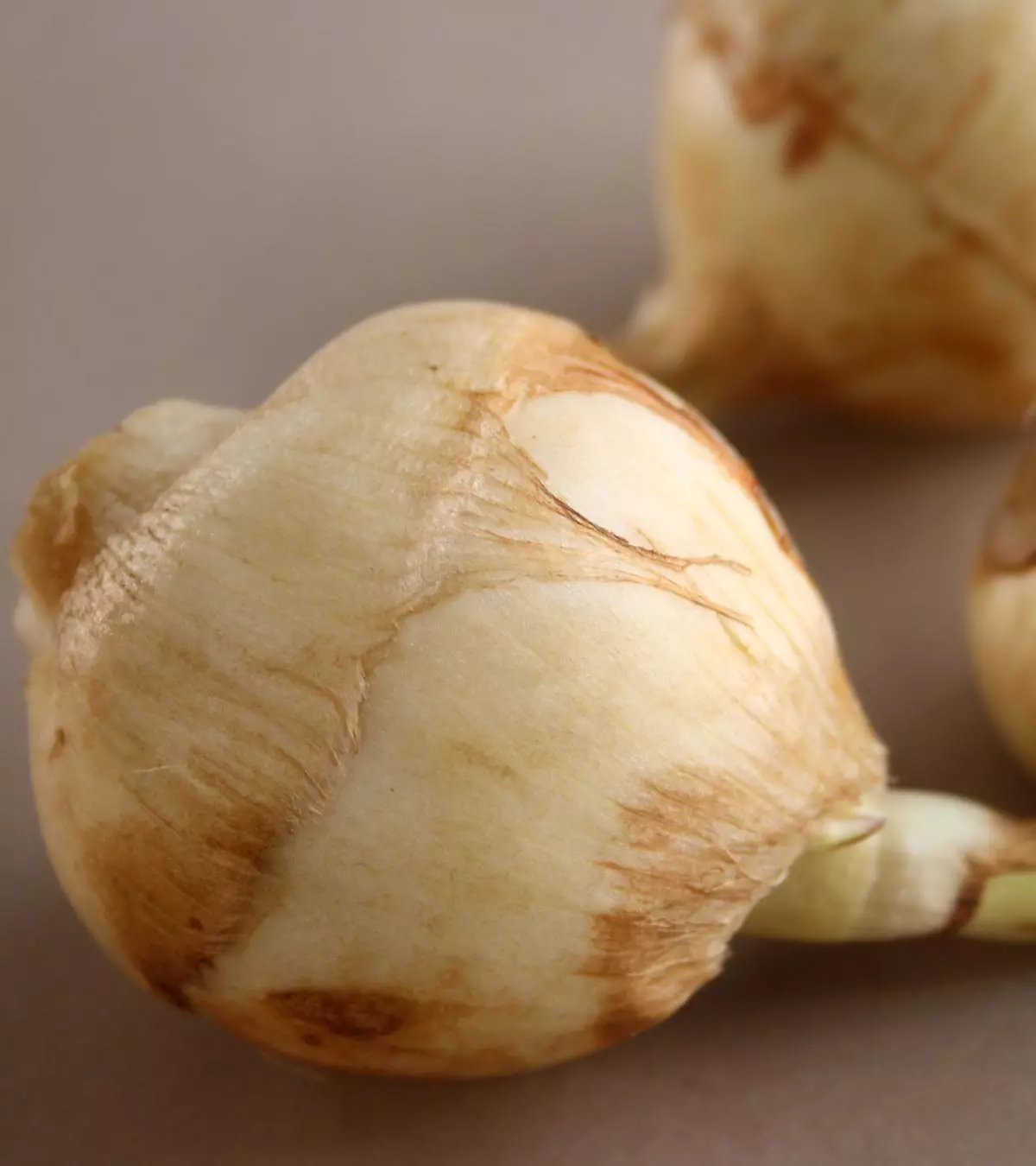
Arrowroot, scientifically known as Maranta arundinacea, is a tuberous product extracted from several tropical plants
. Owing to its amazing nutritional and therapeutic benefits, most parents wish to add arrowroot for babies in powdered or mashed forms when they begin feeding solids. The starch obtained from the roots of arrowroot is often used in powdered form and is known as arrowroot flour. This flour is utilized to prepare commercial powder blends, including baby care products. It is also used as a thickening agent in baby foods. So, wondering if arrowroot is safe for your baby? Read this post to explore the potential health benefits and age-appropriate ways to feed arrowroot for infants. Also included in this post are some interesting arrowroot recipes for babies.
Key Pointers
- Arrowroot is rich in nutrients and is gluten-free.
- Parents can introduce arrowroot into their infant’s diet when they start eating solid foods at six months old.
- One cup of arrowroot flour contains nutrients such as fiber, calcium, iron, magnesium, phosphorus, potassium, sodium, and folate.
- Arrowroot can be incorporated into babies’ diets by blending it into meals like rice or barley water, or by using arrowroot flour in cookies.
- Before giving arrowroot to infants, it’s important to check with a pediatrician to ensure it’s safe for them.
Is Arrowroot Good For Babies?

The flour contains starch and protein. Besides, it is a good source of essential nutrients, like phosphorus, sodium, potassium, magnesium, iron, calcium, and zinc (1).
It is also easy to digest and is gluten-free (2). You can use it as a thickening agent in pureed food. However, just like any other food item, consult a pediatrician before introducing it to the baby. Also try to purchase organic and non-GMO arrowroot that is grown in a sustainable manner.
What Is The Right Age To Introduce Arrowroot To Babies?
Arrowroot can be given to babies as soon as they start solids, which is around the age of six months.
You could consider introducing baby arrowroot cookies as a snack to them (3).
Nutritional Value Of Arrowroot Flour
You can check out the nutritional value of one cup of arrowroot flour and add it to the meals in a way that gives a boost to your infant’s nutrition (4) (5).
| Name | Amount | RDA |
|---|---|---|
| Water | 14.6g | – |
| Energy | 457Kcal | – |
| Protein | 0.384g | – |
| Carbohydrate, by difference | 113g | – |
| Fiber, total dietary | 4.35g | – |
| Calcium, Ca | 51.2mg | 210mg (0-6 months) 270mg (7-12 months) |
| Iron, Fe | 0.422mg | 6mg (0-6 months) 10mg (7-12 months) |
| Magnesium, Mg | 3.84mg | 30mg (0-6 months) 75mg (7-12 months) |
| Phosphorus, P | 6.4mg | 100mg (0-6 months) 275mg (7-12 months) |
| Potassium, K | 14.1mg | 500mg (0-6 months) 700mg (7-12 months) |
| Sodium, Na | 2.56mg | 120mg (0-6 months) 200mg (7-12 months) |
| Folate, total | 8.96µg | 24µg (0-6 months) 32µg (0-12 months) |
Sources: U.S. Department of Agriculture and World Health Organization
The nutritional composition of the arrowroot is promising. Its use, along with breast milk, could help in supporting some of the nutritional needs of the babies and boost their immunity. Therefore, arrowroot is a healthy food choice for supporting infants during their developmental stages.
Possible Health Benefits Of Arrowroot For Babies
The unique nutritional value of arrowroot starch provides some benefits for babies. A few of them are:
- Easy digestion: Arrowroot flour is easy on your infant’s digestive system and, thus, is a good choice for babies who have just started solids.

- Nutrient-dense: Arrowroot is a source of macro and micronutrients. Folate is one such nutrient that is found in arrowroot. This vitamin is essential for cellular regeneration and DNA synthesis (6).
- Digestive health: Arrowroot flour is rich in insoluble dietary fiber, such as starch. Insoluble fiber adds bulk to the diet and regulates the bowel while keeping constipation at bay. It could also help in the management of diarrhea in infants (7).
- Gut health and immunity: Studies suggest that arrowroot flour is a source of prebiotics that could help enhance probiotics in the gut. An increase in probiotics has positive immunomodulatory effects. However, more clinical trials are needed to validate the suggestion (8).
- Teething: Arrowroot flour is used to prepare baby cookies or biscuits that could help your baby during teething. These hard crackers or biscuits are a perfect replacement for plastic, wooden, or amber teethers. Besides, it is believed that arrowroot powder has anti-inflammatory properties that might help heal sore gums while teething.
- Skincare: The topical application of arrowroot powder on sores, cuts, rashes, or painful gums has been shown to provide symptomatic relief. Moreover, it is also used as a replacement for standard baby talcum powder or body powder.
- Diaper rash: In addition to including arrowroot in a baby’s diet and cooking recipes as a thickening agent, one can also use powdered arrowroot for diaper rash treatment in babies and toddlers. Since many talcum powders available in the market may be toxic and have the potency to cause cancer and irritation of lung tissues, baby powder made from starchy plants such as arrowroot powder can make a good and safer alternative (9) (10). They have moisture-absorbing properties that can help treat the diaper rash. However, make sure to use good-quality and organic arrowroot powder, which is free of additives and is especially tailored for baby’s skin.
Ways To Include Arrowroot In Your Baby’s Diet
There are several ways in which you can add arrowroot powder or flour to your infant’s diet.
- For babies who have just started solids, arrowroot powder can be added to their weaning foods, such as barley water and rice water for babies. It would not only enhance the nutritive value of these weaning foods but also thicken their consistency.

- You can add arrowroot to mashed or pureed vegetables and fruits.
- For babies above six months, you can try feeding arrowroot porridge.
- For babies with acid reflux or regurgitation concerns, adding arrowroot powder to breast milk or formula milk might help provide some relief.
 Quick tip
Quick tipNote: Arrowroot allergy is rare but possible. Thus, use it with caution.
When arrowroot powder is not available, other substitutes such as corn starch, rice starch, tapioca starch (from cassava flour) can be used.
Arrowroot Recipes For Babies
Arrowroot is soothing to your baby’s digestive system and is gluten-free. Below are some arrowroot powder recipes that you may like to try.
1. Arrowroot porridge
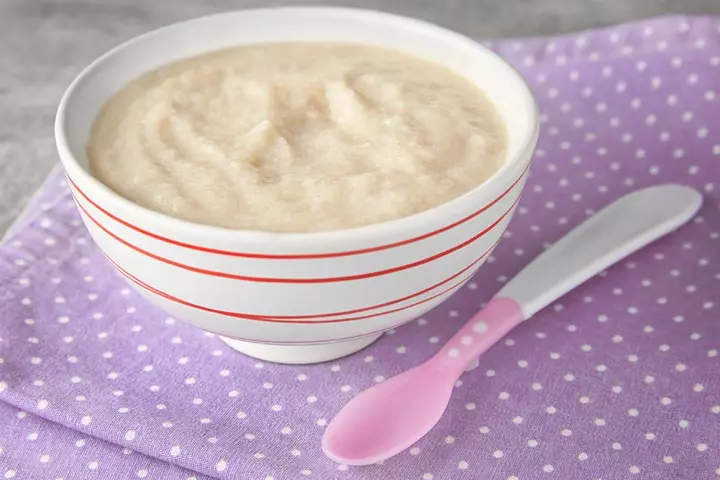
Arrowroot porridge is a nourishing food that can be given to babies once they are about six months of age.
You will need:
- 1 tbsp arrowroot powder
- ½ cup powdered jaggery
- 2 cups water
How to:
- Take one tablespoon of arrowroot powder in a bowl and add a cup of water, along with half a cup of jaggery powder.
- Heat the mixture on a medium flame for about two to three minutes or until you see a thick fluid with a jelly-like consistency. You can adjust the quantity of water as per the thickness you desire.
- Switch off the flame and serve it to your baby while still warm.
2. Arrowroot biscuits

Arrowroot biscuits are most widely used for teething in babies and are also used as snacks and finger food. This is a basic arrowroot biscuit recipe, and you can customize the recipe as per your needs.
You will need:
- ¼ cup butter
- ½ cup brown sugar
- 1 whole egg
- ½tsp vanilla paste
- 1 cup gluten-free flour
- ½ cup arrowroot flour
- ½tsp baking powder
- ¼tsp salt
How to:
- Grease a baking tray. You can also line it with baking paper.
- Take a bowl and mix butter and sugar.
- Add egg and vanilla paste to it and mix everything.
- Stir the remaining dry ingredients and add them to the mix.
- Roll the mixture to a flat sheet with 1cm of thickness.
- As the sheet gets uniformly thick, cut small round pieces with the help of cookie cutters.
- Prick or press with a fork for decoration.
- Bake at 347°F (175°C) for 8-10 minutes or until the biscuits turn golden.
- Once done, take out the cookies or baby crackers from the oven and keep them aside to cool.
- Store them in an airtight container in a refrigerator.
 Did you know?
Did you know?Frequently Asked Questions
1. Are there any side effects of using arrowroot for babies?
There is no medical research that points to the side effects of arrowroot. However, the excessive consumption of arrowroot might cause discomfort and constipation due to its ability to increase fecal bulk (11).
2. Can I use arrowroot to wean my baby off breast milk?
Anecdotally, arrowroot was used to wean children off breast milk (12). However, no research-based medical evidence is available to establish arrowroot as a replacement for breastmilk. Consult your doctor before using arrowroot to wean the baby.
3. How often should I give my baby arrowroot?
It is recommended to introduce arrowroot to babies at the age of six months (3). However, consult your child’s pediatrician on the quantity and how often you can give arrowroot to your infant since excess consumption can lead to discomfort and constipation (11).
4. Is arrowroot suitable for babies with allergies?
Arrowroot is generally considered hypoallergenic so, the likelihood of your baby having an allergic reaction is low. It is also gluten-free, making it suitable for babies with gluten insensitivities. However, if your baby has known allergies or a sensitive stomach, check with their doctor before giving them an arrowroot.
Arrowroot is a gluten-free source of phosphorus, sodium, and various other essential nutrients that are required for the proper development of babies. They can be digested easily and also help in the improvement of immunity and gut health. However, it is advised to consult your doctor before introducing arrowroot for babies. We have also included a few recipes in this post that you can make for your child. You may either purée it or grind it into a powder and add it to your baby’s weaning diet.
Infographic: Interesting Ways To Include Arrowroot In Babies’ Diet
Arrowroot is a white, powdery starch obtained from the roots of certain plants and is considered safe for babies. It is also gluten-free and has several nutritional benefits. So, check out the infographic below to explore healthy and tasty ways to include arrowroot powder in your little one’s diet. Illustration: Momjunction Design Team
Learn how to make a healthy yet delicious arrowroot porridge for your little one in this video and keep them well-nourished.
Illustration: Health Benefits Of Arrowroot For Babies And Recipes To Try
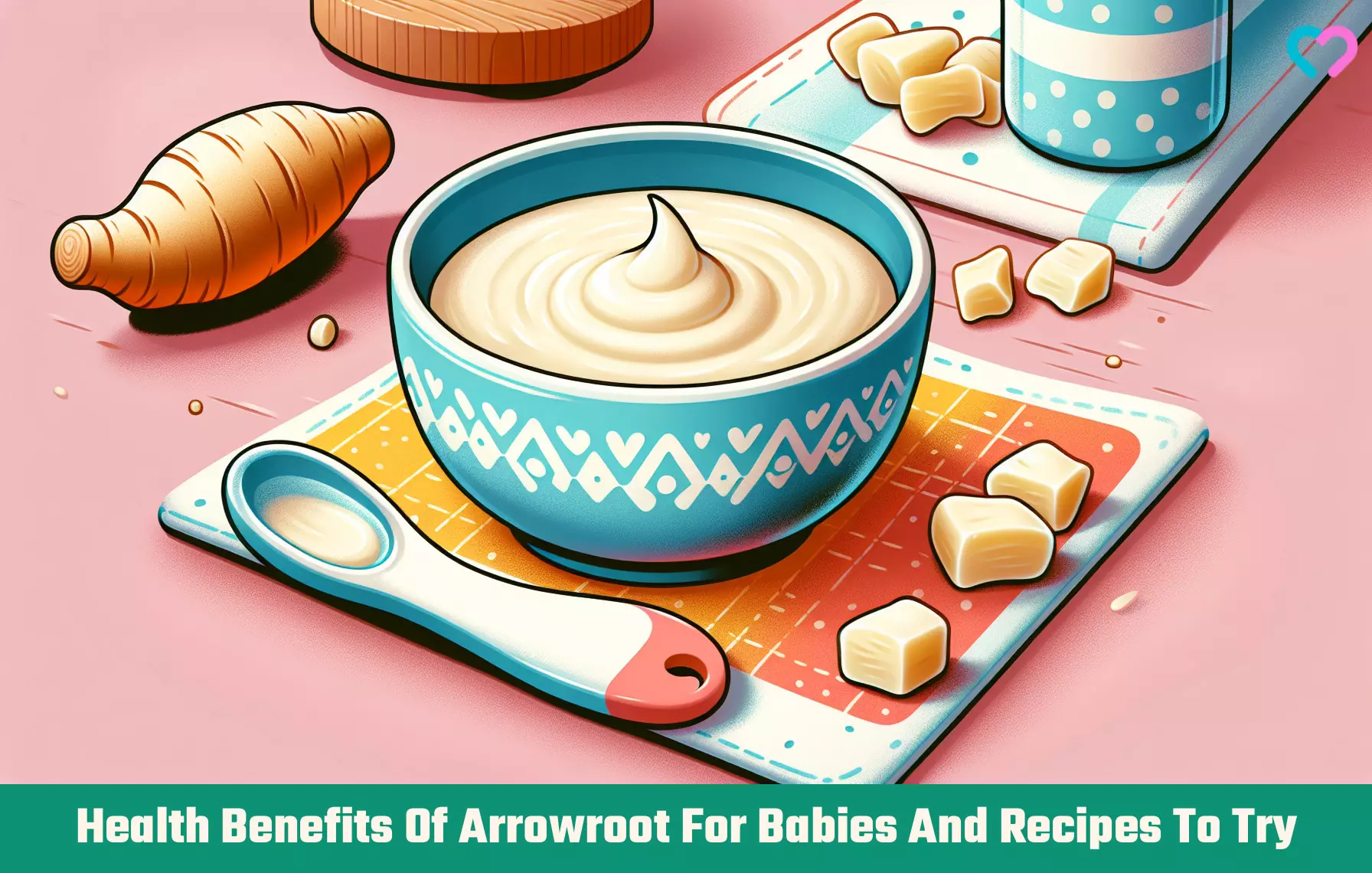
Image: Dall·E/MomJunction Design Team
References
1. Perez E and Lares M; Chemical composition, mineral profile, and functional properties of Canna (Canna edulis) and Arrowroot (Maranta spp.) starches.; National Center For Biotechnology Information
2. AprianitaAprianita et al.; Physicochemical properties of flours and starches derived from traditional Indonesian tubers and roots; National Center For Biotechnology Information
3. Feeding Guide for the First Year; University of Rochester
4. Arrowroot flour, FDC ID: 170684; Food Data Central; USDA
5. Feeding and nutrition of infants and young children; WHO
6. Folic Acid for a Healthy Baby; Stanford Children’s Health
7. Cooke C et al.; Arrowroot as a treatment for diarrhoea in irritable bowel syndrome patients: a pilot study.; National Center For Biotechnology Information
8. IkaDyahKumalasariet al.; Evaluation of immunostimulatory effect of the arrowroot (Marantaarundinacea. L) in vitro and in vivo; National Center For Biotechnology Information
9. Talcum Powder and Cancer: Is Baby Powder Safe?; ConsumerSafety
10. Baby Powder; Missouri Poison Center
11. Cooke et al.; Arrowroot as a treatment for diarrhoea in irritable bowel syndrome patients: a pilot study; NCBI
12. Commercial Interests and Advice on Infant Feeding: Marketing to Mothers in Postwar Queensland; JSTOR – Australian and New Zealand Society of the History of Medicine, Inc
Community Experiences
Join the conversation and become a part of our nurturing community! Share your stories, experiences, and insights to connect with fellow parents.
Read full bio of Jyoti Benjamin
Read full bio of Swati Patwal
Read full bio of Rohit Garoo
Read full bio of Vidya Tadapatri






